文化负载词翻译
英汉文化负载词对比

6、其他
• 1、arachnid 所有蜘蛛类节肢动物的总称 • 来自于Arachne(阿拉喀涅)。Arachne是针织和刺绣技
艺高超的少女,曾同Athene举行过刺绣比赛,因不堪忍受 Athene的污染而自尽。Athene后来很后悔,又对她刺绣 的手艺很敬佩,于是就将她变成为蜘蛛,永远地织网; • 2、atlas 地图集 • Atlas(阿特拉斯)是泰坦(Titans)神族之一,因背叛 Zeus而被罚以双肩扛天。由于荷兰地理学家黑凯托 (Mercator)出版的地图集的扉页上,印有Atlas以双肩扛 天的图片而得名“地图集”; • 3、cereal 谷物 • 源于罗马神话中的Ceres(色列斯),她是掌管谷物和大 地的女神,即希腊神话中的Demeter(狄米特); • 二、希腊罗马神话及其文化负载词
1、希腊罗马神话 2、希腊罗马神话衍生出的文化负载词 (及其翻译) 三、中国神话及其文化负载词 四、总结/对比 五、参考文献
• Apple of discourd 不合的根源 • Damon and Pythias 生死之交 A freedom of Pan 无拘无事,无忧无虑
后羿射日
• 羿是一位擅长射箭的天神,即使是小鸟飞过,羿也能一箭把它射落。
•
传说尧当皇帝的时候,有十个太阳一齐出现在天空,给人类带来
了严重地旱灾。土地烤得直冒烟,禾苗全都枯干,甚至铜铁沙石也晒
得软软的快要熔化了。人民更是不好受,血液在体腔里仿佛在沸腾。
归化与异化视角下的文化负载词翻译
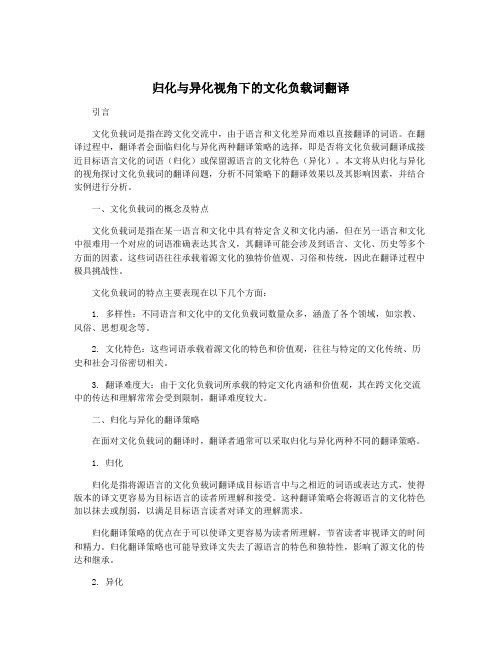
归化与异化视角下的文化负载词翻译引言文化负载词是指在跨文化交流中,由于语言和文化差异而难以直接翻译的词语。
在翻译过程中,翻译者会面临归化与异化两种翻译策略的选择,即是否将文化负载词翻译成接近目标语言文化的词语(归化)或保留源语言的文化特色(异化)。
本文将从归化与异化的视角探讨文化负载词的翻译问题,分析不同策略下的翻译效果以及其影响因素,并结合实例进行分析。
一、文化负载词的概念及特点文化负载词是指在某一语言和文化中具有特定含义和文化内涵,但在另一语言和文化中很难用一个对应的词语准确表达其含义,其翻译可能会涉及到语言、文化、历史等多个方面的因素。
这些词语往往承载着源文化的独特价值观、习俗和传统,因此在翻译过程中极具挑战性。
文化负载词的特点主要表现在以下几个方面:1. 多样性:不同语言和文化中的文化负载词数量众多,涵盖了各个领域,如宗教、风俗、思想观念等。
2. 文化特色:这些词语承载着源文化的特色和价值观,往往与特定的文化传统、历史和社会习俗密切相关。
3. 翻译难度大:由于文化负载词所承载的特定文化内涵和价值观,其在跨文化交流中的传达和理解常常会受到限制,翻译难度较大。
二、归化与异化的翻译策略在面对文化负载词的翻译时,翻译者通常可以采取归化与异化两种不同的翻译策略。
1. 归化归化是指将源语言的文化负载词翻译成目标语言中与之相近的词语或表达方式,使得版本的译文更容易为目标语言的读者所理解和接受。
这种翻译策略会将源语言的文化特色加以抹去或削弱,以满足目标语言读者对译文的理解需求。
归化翻译策略的优点在于可以使译文更容易为读者所理解,节省读者审视译文的时间和精力。
归化翻译策略也可能导致译文失去了源语言的特色和独特性,影响了源文化的传达和继承。
2. 异化异化是指在翻译过程中尽量保留源语言的文化特色和独特性,使得译文更贴近源语言的文化体系和价值观。
这种翻译策略在文化负载词的翻译中会更加突出源文化的内涵和独特性,有利于传达文化的多样性和丰富性。
《功能对等理论下文化负载词的翻译》

《功能对等理论下文化负载词的翻译》一、引言在全球化的背景下,翻译作为一种文化交流的桥梁,其重要性日益凸显。
功能对等理论作为翻译理论的重要组成部分,为文化负载词的翻译提供了有力的指导。
文化负载词,即承载着特定文化内涵的词汇,其翻译往往涉及到文化背景、习俗、历史等多个方面的因素。
本文旨在探讨功能对等理论在文化负载词翻译中的应用,并分析其优势和局限性。
二、功能对等理论的概述功能对等理论是一种翻译理论,它强调在翻译过程中保持原文与译文在信息内容、语言形式、文化内涵和交际效果等方面的对等。
该理论认为,翻译的目的是使译文读者获得与原文读者相似的感受和理解。
在文化负载词的翻译中,功能对等理论要求译者在保持原词文化内涵的同时,尽量使译文在目的语文化中产生类似的联想和意义。
三、功能对等理论在文化负载词翻译中的应用1. 音译法音译法是一种常见的文化负载词翻译方法,通过将原词的发音转化为目的语中的近似发音,以保留原词的文化特色。
在功能对等理论的指导下,音译法要求译者在保持原词发音的同时,尽量使译文在目的语中产生相似的意义和文化内涵。
例如,“功夫(Kung Fu)”的翻译就采用了音译法,成功地将中国武术的文化内涵传递给了目的语读者。
2. 意译法意译法是通过理解原词的含义,将其转化为目的语中的相应表达,以传达原词的文化内涵。
在功能对等理论的指导下,意译法要求译者在理解原词含义的基础上,尽量使译文在目的语中产生与原文相似的文化联想和意义。
例如,“龙(Dragon)”在西方文化中往往被视为邪恶的象征,而在中国文化中则被视为吉祥、权力的象征。
在翻译时,译者需要根据目的语读者的文化背景进行适当的调整,以传达原词的文化内涵。
3. 释义法释义法是通过直接解释原词的含义来传达其文化内涵。
在功能对等理论的指导下,释义法要求译者在解释原词含义的同时,尽量使译文在目的语中产生与原文相似的语境和情感色彩。
例如,“四合院(Siheyuan)”这一文化负载词的翻译,可以通过解释其为中国传统民居建筑形式,具有独特的建筑风格和历史文化内涵,来帮助目的语读者理解其含义。
中文文化负载词翻译策略与方法
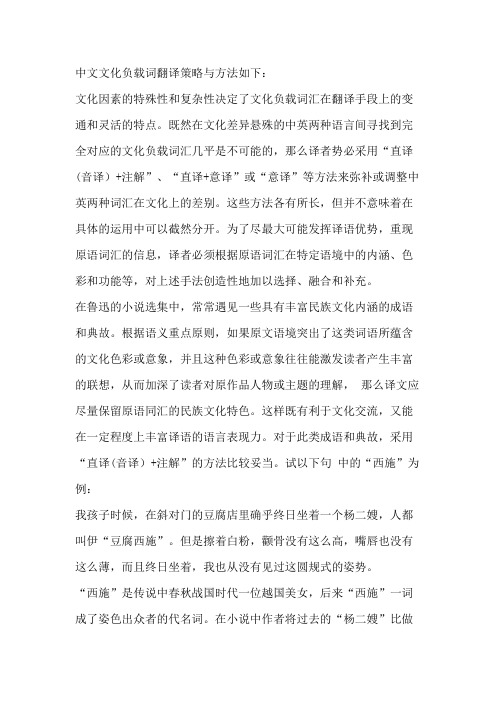
中文文化负载词翻译策略与方法如下:文化因素的特殊性和复杂性决定了文化负载词汇在翻译手段上的变通和灵活的特点。
既然在文化差异悬殊的中英两种语言间寻找到完全对应的文化负载词汇几平是不可能的,那么译者势必采用“直译(音译)+注解”、“直译+意译”或“意译”等方法来弥补或调整中英两种词汇在文化上的差别。
这些方法各有所长,但并不意味着在具体的运用中可以截然分开。
为了尽最大可能发挥译语优势,重现原语词汇的信息,译者必须根据原语词汇在特定语境中的内涵、色彩和功能等,对上述手法创造性地加以选择、融合和补充。
在鲁迅的小说选集中,常常遇见一些具有丰富民族文化内涵的成语和典故。
根据语义重点原则,如果原文语境突出了这类词语所蕴含的文化色彩或意象,并且这种色彩或意象往往能激发读者产生丰富的联想,从而加深了读者对原作品人物或主题的理解,那么译文应尽量保留原语同汇的民族文化特色。
这样既有利于文化交流,又能在一定程度上丰富译语的语言表现力。
对于此类成语和典故,采用“直译(音译)+注解”的方法比较妥当。
试以下句中的“西施”为例:我孩子时候,在斜对门的豆腐店里确乎终日坐着一个杨二嫂,人都叫伊“豆腐西施”。
但是擦着白粉,颧骨没有这么高,嘴唇也没有这么薄,而且终日坐着,我也从没有见过这圆规式的姿势。
“西施”是传说中春秋战国时代一位越国美女,后来“西施”一词成了姿色出众者的代名词。
在小说中作者将过去的“杨二嫂”比做“西施”,是別具匠心的。
记忆中的杨二嫂是公认的如西施一般美丽的女人,而如今却被生活折磨成凶悍、尖刻、如同“圆规”般丑陋的人物。
“西施”与“圆规”两种迥然不同的形象对照,深刻地展现了小说的主题:现实与理想的冲突,美好事物的虚幻及憧憬的破灭。
作者实际上通过对人物外貌的刻画揭示了人物内心世界的本质变化。
为了帮助英语读者在阅读中也能感受到作者在这篇小说中特有的鲜明对照,“西施”一词的翻译就应该强调突出文化意象,采用“音译+注释”的方法。
从语义空缺角度谈文化负载词的分类及翻译

从语义空缺角度谈文化负载词的分
类及翻译
文化负载词是指在语言传递过程中,因为其承载的特定文化信息而引起的语义空缺。
它们不同于普通的词汇,在翻译过程中常常会出现语义上的混乱和理解错误。
根据文化负载的方式不同,可以将文化负载词分为以下几类:
1、语言文化负载词:这类文化负载词主要指的是某一特定语言中的词汇,比如汉语中的“面子”,在英语中没有相应的替代词,只能用“face”来表达,但是由于其在汉语中承载的文化信息,使得“面子”难以完全用“face”来表达。
2、历史文化负载词:这类文化负载词指的是某一特定历史时期的特定词汇,比如清朝的“贡生”,在现代时代已经失去了它原有的文化意义,因此没有一个现代的语言可以完全表达它的文化内涵。
3、社会文化负载词:这类文化负载词指的是某一特定社会时期的特定词汇,比如“小资”,它是一种对当下社会经济状况的文化说明,在其他社会时期或其他社会中并不存在。
翻译文化负载词时,首先需要弄清楚原文中文化负载词承载的文化信息,然后再根据译文的文化背景选择合适的表达方式,以使原文的文化信息能够在译文中得到充分的体现。
浅谈英汉文化负载词及其翻译

浅谈英汉文化负载词及其翻译
从词汇翻译的角度看,语义可分为表层意义,即词的指称意义,和深层意义,即内涵意义。
文化负载词的文化内涵意义就是指在文化词汇的实体指称意义的基础上,添加的反映某一特定民族文化的语义,即文化附加义。
由于民族文化存在个性差异,文化负载词翻译中的文化信息对等往往很难达到指称意义和文化内涵意义的完全传达。
为使译文和原文最大限度的等值,传递较完整的文化意义,翻译策略的运用就尤其重要。
文化负载词的翻译策略简要分类如下:音译。
就英译中而言,音译主要是指用汉语中谐音的字或字的组合翻译英语的词语,而这些字或字的组合并不是汉语现成的有意义的词。
汉英翻译第一章文化负载词

Culture-loaded words
• 1. Please find out the words with Chinese characteristics in the passage on page 23. • 2. how does the writer translate these words on the next page? • 3. how do you call these words with Chinese characterist• •
文化负 载词的翻译方法 1. 直译法 1)龙舟 2)八宝菜 3)文化大革命 4)纸老虎 5)号脉 6)春节 7)春卷
Dragon boat Eight-treasure pickles Cultural Revolution Paper tiger Feel the pulse Spring Festival Spring roll
• 关于兔儿爷还有一段传说:一年,北京城里忽然起了瘟疫, 几乎每家都有人得了,就治不好。嫦娥看到此情景,心里 十分难过,就派身边的玉兔去为百姓们治病。玉兔变成了 一个少女,她挨家挨户地走,治好了很多人。人们为了感 谢玉兔,纷纷送东西给她;可玉兔什么也不要,只是向别 人借衣服穿,每到一处就换一身装扮,有时候打扮得像个 卖油的,有时候又像个算命的……一会儿是男人装束,一 会儿又是女人打扮。为了能给更多的人治病,玉兔就骑上 马、鹿或狮子、老虎,走遍了京城内外。消除了京城的瘟 疫之后,玉兔就回到月宫中去了。于是,人们用泥塑造了 玉兔的形象,有骑鹿的,有乘凤的,有披挂着铠甲的,也 有身着各种做工人的衣服的,千姿百态,非常可爱。每到 农历八月十五那一天,家家都要供奉她,给她摆上好吃的 瓜果菜豆,用来酬谢她给人间带来的吉祥和幸福,还亲切 地称她为“兔爷儿”、“兔奶奶”。
《红楼梦》中宗教文化负载词翻译

《红楼梦》中宗教文化负载词翻译传统意义上的国家安全,仅涉及政治、经济和军事领域。
但随着世界文化交流的迅猛发展,国家和民族间文化对话和交往的领域持续扩大,水准持续加深,“现实地存有着国家间的文化力量博弈,文化大国或强国在国际文化博弈中可能表现为文化扩张或文化渗透,而文化弱国则可能面临这种扩张和渗透的威胁。
”[1]外部世界对中国文化的感知与理解,对中国文化的精髓与价值的理解与认同,都会影响到中国文化形象的树立和文化感召力与吸引力的建构。
这种文化形象与文化感召力,构成了一个中国的对外文化实力。
国家的对外文化实力是综合国力的有机组成部分,对国家的政治、经济实力的构筑与增强起到了支撑作用。
所以,捍卫国家安全的重要方面就是构建国家文化安全堡垒,促动国家文化走出去,在外部建立文化安全先锋。
这个思想,已经得到我国国家政策层面的支持。
十七届六中全会发布的《中共中央关于深化文化体制改革推动社会主义文化大发展大繁荣若干重大问题的决定》就明确提出要实施中国文化“走出去”工程,这标志着我国将通过建设文化强国、树立国家文化形象、扩展国家文化感召力来增强国家综合文化实力、维护国家文化安全作为一个重要的战略内容和目标。
对外文化交流的重要内容,是中国传统文化典籍的对外传播。
中国典籍是中国文化的重要组成,不但是中国文化的结晶,更是中国传统文化的载体,具有鲜明的民族性。
在中外文化交流史上,译为外语的中国典籍为外部世界提供了一条了解中国的渠道,在很多场合甚至是吸引国外人士理解中国、注重中国的重要激发者。
中国典籍的对外传播,首要步骤就是典籍的外译。
较好地传递中国典籍中文化信息的译本,能够宣扬本国的优秀思想文化,拉近中华文化与其他国家文化之间的距离,增进世界对中国的了解,提升中国在国际上的地位和形象,扩大中国文化的影响力,为中国展开经济等交流开辟良好的国际环境。
而未能准确、清楚地传递文化信息的译本,则会造成中国文化被曲解和解构,中国国家形象和对外吸引力会消损。
文化负载词在四级考试汉译英中的翻译

文化负载词在四级考试汉译英中的翻译1. 引言1.1 文化负载词在四级考试汉译英中的翻译Culture-loaded words refer to words that are deeply rooted in a specific culture and may carry unique cultural connotations. In the context of the Chinese-English translation in the CET-4 exam, understanding and accurately translating culture-loaded words is crucial for achieving a high score.2. 正文2.1 文化负载词的定义Culture-loaded words refer to words and phrases that carry specific cultural meanings and connotations, making them difficult to translate directly into another language. These words often reflect the values, beliefs, and social norms of a particular culture, and may not have direct equivalents in other languages.2.2 文化负载词在四级考试的重要性文化负载词在四级考试中扮演着非常重要的角色。
它们既是考察考生英语翻译能力的一个重要方面,同时也是考察考生对外语文化的理解和掌握程度的表现。
由于文化在语言中起到了至关重要的作用,因此在考试中对文化负载词的翻译是不可或缺的。
文化负载词的准确翻译能够帮助考生更好地理解和把握文章的内容。
互文性视角下《挪威的森林》中文化负载词的汉译
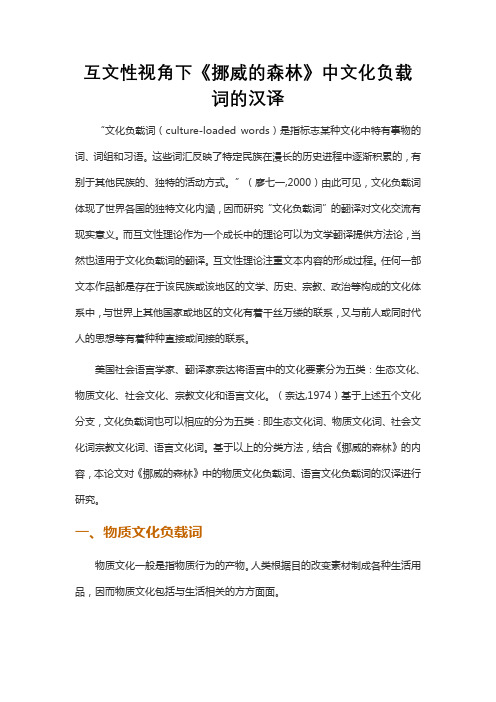
互文性视角下《挪威的森林》中文化负载词的汉译“文化负载词(culture-loaded words)是指标志某种文化中特有事物的词、词组和习语。
这些词汇反映了特定民族在漫长的历史进程中逐渐积累的,有别于其他民族的、独特的活动方式。
”(廖七一,2000)由此可见,文化负载词体现了世界各国的独特文化内涵,因而研究“文化负载词”的翻译对文化交流有现实意义。
而互文性理论作为一个成长中的理论可以为文学翻译提供方法论,当然也适用于文化负载词的翻译。
互文性理论注重文本内容的形成过程。
任何一部文本作品都是存在于该民族或该地区的文学、历史、宗教、政治等构成的文化体系中,与世界上其他国家或地区的文化有着千丝万缕的联系,又与前人或同时代人的思想等有着种种直接或间接的联系。
美国社会语言学家、翻译家奈达将语言中的文化要素分为五类:生态文化、物质文化、社会文化、宗教文化和语言文化。
(奈达,1974)基于上述五个文化分支,文化负载词也可以相应的分为五类:即生态文化词、物质文化词、社会文化词宗教文化词、语言文化词。
基于以上的分类方法,结合《挪威的森林》的内容,本论文对《挪威的森林》中的物质文化负载词、语言文化负载词的汉译进行研究。
一、物质文化负载词物质文化一般是指物质行为的产物。
人类根据目的改变素材制成各种生活用品,因而物质文化包括与生活相关的方方面面。
例1:授業料高いし、寄付もしょっちゅうあるし、修学旅行っていや京都の高級旅館を借りきって塗りのお膳で懐石料理食べるし、年に一回ホテル·オークラの食堂でテーブル·マナーの講習があるし、とにかく普通じゃないのよ。
林译:学费高,还时不时的要赞助,修学旅行住的是京都的高级旅馆,用真漆器碗吃“怀石料理”(日本京都地区一种别具风味的斋菜),每年还要去大仓酒店的餐厅参加一次宴会礼仪的讲习班。
总之不同一般。
赖译:学费很贵,经常要捐款,说到修业旅行还包下京都的高级旅馆,用漆器餐具吃怀石料理,一年一次到Hotel Okura的餐厅讲习西餐礼仪,总之不是普通的哦。
文化负载词翻译的开题报告

文化负载词翻译的开题报告开题报告题目:文化负载词翻译一、选题背景和意义随着全球化的推进,不同国家和地区的文化交流与融合日趋频繁,翻译在文化传播中起着重要作用。
文化负载词是指在翻译过程中具有文化特点,难以准确翻译的词汇。
它们往往承载着丰富的社会文化背景和意义,直接反映了不同语言和文化的差异。
因此,研究文化负载词的翻译问题对于提高翻译质量、促进跨文化交流具有重要意义。
二、研究目标本研究的目标是探讨文化负载词的翻译方法和策略,以提高文化负载词的翻译质量和效果。
具体而言,研究将聚焦于以下几个方面:1. 研究分析不同文化背景下的典型文化负载词,深入了解其特点和意义。
2. 分析文化负载词翻译中存在的问题和挑战,总结常见的翻译错误和困难。
3. 探讨文化负载词翻译的方法和策略,研究如何准确传达文化负载词所承载的意义。
4. 提出针对不同文化负载词的翻译建议和实践指导,以提高翻译质量和效果。
三、研究方法和步骤本研究将采用以下方法和步骤进行:1. 文献研究:通过阅读相关文献和研究成果,了解文化负载词的研究现状和翻译方法,为后续研究提供理论基础。
2. 数据收集:收集不同文化背景下的典型文化负载词,并分析其语言特点、文化意义和翻译难点。
3. 方法论研究:结合文献研究和数据分析,探讨文化负载词的翻译方法和策略,寻找准确传达其文化意义的方式。
4. 翻译案例分析:选取一些具有代表性的文化负载词,在不同语境中进行翻译,分析其翻译效果和存在的问题。
5. 翻译建议和实践指导:基于研究结果,提出针对不同文化负载词的翻译建议和实践指导,为翻译工作者提供参考和借鉴。
四、预期成果通过对文化负载词翻译的研究,预期达到以下成果:1. 对不同文化背景下的典型文化负载词进行深入研究,全面了解其特点和意义。
2. 分析文化负载词翻译中的问题和挑战,总结常见的翻译错误和困难。
3. 提出文化负载词翻译的方法和策略,以准确传达其文化意义。
4. 通过翻译案例分析,评估不同翻译方法的效果和优劣。
《文化与翻译》文化负载词的处理解析

从双语平行语料我们观察到四点(何元建, 2010:214): 1) 白皮书属于敏感类文本,也属于所谓权 威性文本(authoritative texts)。之所以敏感, 原因就是传递了本源概念。因此,译者极 少有省略、换译以及意译的选择;唯一可 行的策略就是直译,对直译的文字也不加 注释(原因大概是译者无权或者无权威做出 注释)。
5) 本源概念的翻译(何元建,2010) 本源概念(indigenous information)指某一 语言社团在自己的历史、文化、社会和思 维方式发展过程中孕育出的特有概念。它 对于另外一个语言社团是外来的(alien)(何 元建,2010:211)。
从语义与语用的角度,信息不外乎有两种:1) 为源语社团与文化和译语社团与文化所共 享,或称通用信息(shared information);2) 为源语社团与文化所独享,或称本源信息 或概念(何元建,2010:211)。
2)王东风(2000:248-253) 1、文外作注: 直译加注释。 2、文内明示: 直译与意译相结合 3、归化(替换) 4、删除 5、硬译: 按字面照译原文。
3)刘宓庆(2007:248-256) 翻译中文化信息的表现手段:图像(图表)、模仿 (直译)、替代、阐释和淡化(decoloration)。
1)白皮书 从已经完成的数据库中,抽出150处政治、 政策、意识形态概念。其中有一处省略:“加 强宣传力度”(无译文) , 有一处意译:“三座 大山”(imperialism,feudalism and bureaucrat-capitalism) ,余下148 处都是直译 (没有一处有注释)。 2)《围城》 从已经完成的数据库中,抽出89处汉文化本 源概念(划线部分)。有42处直译(无注释), 33处意译,14处换译,没有省略。
《边城》中文化负载词的翻译
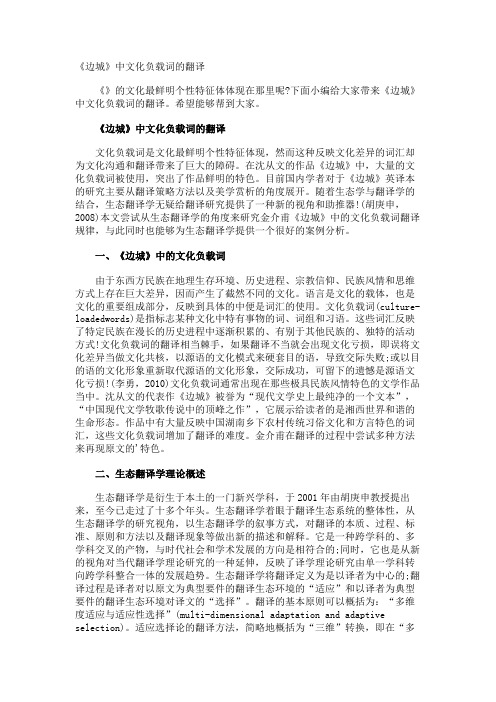
《边城》中文化负载词的翻译《》的文化最鲜明个性特征体体现在那里呢?下面小编给大家带来《边城》中文化负载词的翻译。
希望能够帮到大家。
《边城》中文化负载词的翻译文化负载词是文化最鲜明个性特征体现,然而这种反映文化差异的词汇却为文化沟通和翻译带来了巨大的障碍。
在沈从文的作品《边城》中,大量的文化负载词被使用,突出了作品鲜明的特色。
目前国内学者对于《边城》英译本的研究主要从翻译策略方法以及美学赏析的角度展开。
随着生态学与翻译学的结合,生态翻译学无疑给翻译研究提供了一种新的视角和助推器!(胡庚申,2008)本文尝试从生态翻译学的角度来研究金介甫《边城》中的文化负载词翻译规律,与此同时也能够为生态翻译学提供一个很好的案例分析。
一、《边城》中的文化负载词由于东西方民族在地理生存环境、历史进程、宗教信仰、民族风情和思维方式上存在巨大差异,因而产生了截然不同的文化。
语言是文化的载体,也是文化的重要组成部分,反映到具体的中便是词汇的使用。
文化负载词(culture-loadedwords)是指标志某种文化中特有事物的词、词组和习语。
这些词汇反映了特定民族在漫长的历史进程中逐渐积累的、有别于其他民族的、独特的活动方式!文化负载词的翻译相当棘手,如果翻译不当就会出现文化亏损,即误将文化差异当做文化共核,以源语的文化模式来硬套目的语,导致交际失败;或以目的语的文化形象重新取代源语的文化形象,交际成功,可留下的遗憾是源语文化亏损!(李勇,2010)文化负载词通常出现在那些极具民族风情特色的文学作品当中。
沈从文的代表作《边城》被誉为“现代文学史上最纯净的一个文本”,“中国现代文学牧歌传说中的顶峰之作”,它展示给读者的是湘西世界和谐的生命形态。
作品中有大量反映中国湖南乡下农村传统习俗文化和方言特色的词汇,这些文化负载词增加了翻译的难度。
金介甫在翻译的过程中尝试多种方法来再现原文的'特色。
二、生态翻译学理论概述生态翻译学是衍生于本土的一门新兴学科,于2001年由胡庚申教授提出来,至今已走过了十多个年头。
试评《红楼梦》中文化负载词的翻译
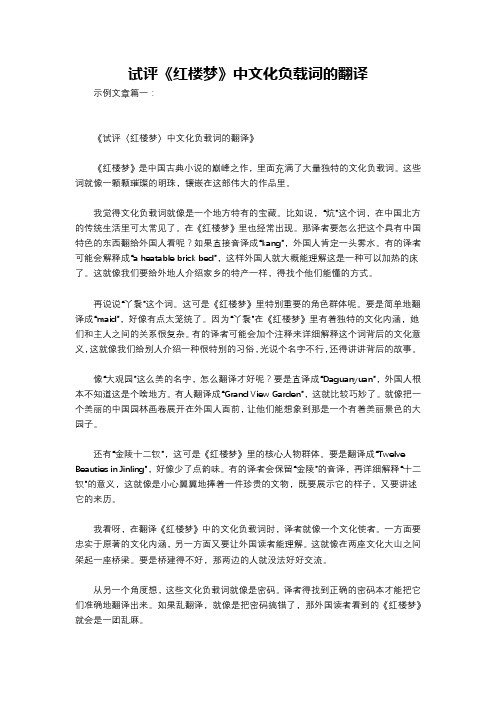
试评《红楼梦》中文化负载词的翻译示例文章篇一:《试评〈红楼梦〉中文化负载词的翻译》《红楼梦》是中国古典小说的巅峰之作,里面充满了大量独特的文化负载词。
这些词就像一颗颗璀璨的明珠,镶嵌在这部伟大的作品里。
我觉得文化负载词就像是一个地方特有的宝藏。
比如说,“炕”这个词,在中国北方的传统生活里可太常见了。
在《红楼梦》里也经常出现。
那译者要怎么把这个具有中国特色的东西翻给外国人看呢?如果直接音译成“kang”,外国人肯定一头雾水。
有的译者可能会解释成“a heatable brick bed”,这样外国人就大概能理解这是一种可以加热的床了。
这就像我们要给外地人介绍家乡的特产一样,得找个他们能懂的方式。
再说说“丫鬟”这个词。
这可是《红楼梦》里特别重要的角色群体呢。
要是简单地翻译成“maid”,好像有点太笼统了。
因为“丫鬟”在《红楼梦》里有着独特的文化内涵,她们和主人之间的关系很复杂。
有的译者可能会加个注释来详细解释这个词背后的文化意义,这就像我们给别人介绍一种很特别的习俗,光说个名字不行,还得讲讲背后的故事。
像“大观园”这么美的名字,怎么翻译才好呢?要是直译成“Daguanyuan”,外国人根本不知道这是个啥地方。
有人翻译成“Grand View Garden”,这就比较巧妙了。
就像把一个美丽的中国园林画卷展开在外国人面前,让他们能想象到那是一个有着美丽景色的大园子。
还有“金陵十二钗”,这可是《红楼梦》里的核心人物群体。
要是翻译成“Twelve Beauties in Jinling”,好像少了点韵味。
有的译者会保留“金陵”的音译,再详细解释“十二钗”的意义,这就像是小心翼翼地捧着一件珍贵的文物,既要展示它的样子,又要讲述它的来历。
我看呀,在翻译《红楼梦》中的文化负载词时,译者就像一个文化使者。
一方面要忠实于原著的文化内涵,另一方面又要让外国读者能理解。
这就像在两座文化大山之间架起一座桥梁。
要是桥建得不好,那两边的人就没法好好交流。
文化负载词的翻译

02
技术发展为文化负载词的翻译提供了更多可能性,如利用大数
据和语料库进行翻译比对和优化。
技术发展也带来了一些挑战,如如何确保机器翻译的准确性和
03
文化敏感性。
文化负载词翻译研究的趋势与展望
当前,文化负载词的翻译研究正朝着跨学科的方向发展,涉及语言学、文 化学、社会学等多个领域。
未来,随着全球化的深入和技术的进步,文化负载词的翻译将更加注重语 境和文化背景的考量。
总结词
旅游资料中的文化负载词翻译需要注重 传递旅游目的地的文化和历史信息,同 时要考虑到游客的文化背景和语言水平。
详细描述
旅游资料中的文化负载词是旅游目的地文化和历史的重要载体,对于游客了解目的地具有重要意义。在翻译过程 中,译者需要准确传递原文的文化和历史信息,同时要考虑到游客的语言水平和文化背景,使译文更加易于理解 和接受。此外,译者还需要注意译文的规范性和可读性,以提升游客的旅游体验。
展望未来,翻译界应加强合作与交流,共同推动文化负载词翻译研究的深 入发展,以更好地服务于全球范围内的跨文化交流。
感谢您的观看
THANKS
05
文化负载词的翻译标准与评 价
翻译标准
准确性
译文应准确地传达原文的含义,避免歧义或误解。
流畅性
译文应流畅自然,符合目标语言的表达习惯,易于理解。
文化敏感性
译文应尊重源语言和目标语言的文化背景,避免文化冲突或误解。
信息完整性
译文应完整地传达原文的信息,包括语气、情感和风格等。
评价方法
对比分析法
将原文与译文进行对比,评估译文的准确性、 流畅性和文化敏感性等方面。
读者反馈法
通过调查或测试的方式,收集目标读者对译 文的评价和反馈。
- 1、下载文档前请自行甄别文档内容的完整性,平台不提供额外的编辑、内容补充、找答案等附加服务。
- 2、"仅部分预览"的文档,不可在线预览部分如存在完整性等问题,可反馈申请退款(可完整预览的文档不适用该条件!)。
- 3、如文档侵犯您的权益,请联系客服反馈,我们会尽快为您处理(人工客服工作时间:9:00-18:30)。
四川师范大学文理学院本科毕业论文Translation of Chinese Culture-loaded Words 中国文化负载词的翻译作者:郑秋红院系:文理学院外语系年级: 2006级专业班级:英语(师范)2班学号: 6411106232指导教师:刘慧玲答辩日期: 4月24日中国文化负载词的翻译学生:郑秋红指导教师:刘慧玲摘要:中国文化负载词是表达中国文化中的特有事物,当中国的文化传出中国走向世界的时候,这些文化负载词又是怎样不失原味的被翻译成外语,被外国人所接受的呢? 本文从中式英语、中国特色词汇和中国文化负载词的对比分析入手,尝试探讨中国文化负载词的特点,分析文化负载词英译中出现的各种问题及其成因。
最后得出结论:在中国文化负载词英译中,译者可以通过意译、直译、意译等方法实现文化负载词的转化和使用,从而逐渐融入传统英语中,为英语使用者所接受。
关键词:中国文化负载词;文化差异;翻译Translation of Chinese Culture-loaded Words Abstract: Each language contains elements which are derived from its culture, such as idioms, proverbs, and other fixed expressions. Translation is not only an Interlingua transfer,but also a cross-cultural communication. Chinese culture-loaded words are becomingincreasingly important in the study of China English. Chinese culture-loaded wordsrefer to the uniqueness of Chinese items, and of course, contain the connotation ofChinese culture. With the wide spread of Chinese culture to the world, how can they beunderstood and accepted by foreigners accurately in translation? The paper, by giving agood number of examples, introduces some methods of translating Chineseculture-loaded words, including transliteration, literal translation, and free translationand so on. These methods help to understand how Chinese culture-loaded words aretransformed into and used in English.Key words: Chinese culture-loaded words; culture differences; translationContentsIntroduction (1)Part ⅠThe relation between Chinese Culture and Chinese Culture-loaded word (2)1.1Culture-loaded word, China English and Chinglish (2)1.2 The characteristics of Chinese Culture-loaded words (3)1.3 The influence of Chinese culture on Chinese Culture-loaded words (4)Part ⅡThe translation difficulties of Chinese culture-loaded word (7)2.1 The lexical gap which caused by traditional history culture (7)2.2 The lexical gap caused by the Regional cultural differences (8)2.3 The lexical gap caused by the differences of customs and cultures (8)Part ⅢTranslation methods of Chinese Culture-loaded words (10)3.1 Hypo taxis and Parataxis (10)3.2 Translation methods in culture-loaded words (11)3.2.1 Transliteration plus free translation (11)3.2.2 Literal Translation plus free translation (12)3.2.3 Interpretation in culture-loaded words (13)Conclusion (15)Bibliography (16)IntroductionToday, English is undeniably becoming a more widely used international language, and it is the interaction tool between countries. Along with the accelerated process of global integration, China’s foreign deepening of reform and opening up and China’s further economic development, a large number of new terms appeared in modern Chinese, including the old words with new meaning, buzzwords, new alien words and expressions, etc.; even many old words that have been annihilated for many years frequently appears. Words with Chinese characteristics are part of the culture-loaded words. Therefore the research of words with Chinese characteristics will gradually become an important discussion of the subject on China’s English teaching and the research community. Cultural-loaded words, as a series of symbols for communication, are the carriers of national culture. They not only open up the unique characteristics of a nation, but also bring difficulties and confusion to English learners Mr.SunZhili said, “It is the meaning of the culture that makes the translation the most difficult rather than the language itself.” Mr.WangZuoliang has also said, “The most difficulty of translation is the difference of two different cul tures.” Mr.LiuShouhua thinks, “People with different culture have different view to the real world, therefore making their own language demonstrate uniqueness and nationality in its development.”Cultural terms have different names, such as culture-loaded words, cultural vacancies words, vocabulary vacancies. This paper prepares to discuss the translation of Chinese culturally-loaded words in the following aspects: the characteristics of Chinese culturally-loaded words and the reason why it come into being, and will also introduce some of the translation methods of the Chinese culturally-loaded words.Part ⅠThe relation between Chinese Culture and ChineseCulture-loaded word1.1Culture-loaded word, China English and ChinglishSince China is a country with a long history of more than 5000 years, during which it has cultivated and accumulated a broad and profound culture. Chinese culture-loaded words refer to the uniqueness of Chinese items, and of course, contain the connotation of Chinese culture, such as “Baxianguohai”in the “Eight Immortals”Who was this guy?Which, “Liu Qin”? There is a saying called “seven things” (seven daily needs of household), which “7”?“柴米油盐酱醋茶”(fuel, rice, oil, soy sauce, vinegar and tea) somehow is highlighted. As for the “三教九流”can be translated into people of all sorts, people of different social origins and backgrounds and so on English words with Chinese culture can be regarded as China English, which is almost the same with culture-loaded words. While China English is absolutely different from Chinglish. It is necessary to make it clear what are China English and Chinglish. China English, mainly used as an international language in China, with Chinese unique borrowings, or phrases, contributes much to the international communication. In contrast, Chinglish refers to the English usually created by inferior Chinese English learners, who translate English into their own words so arbitrarily, that the interpretation fails to accord with grammar rules or custom usages, thus being regarded as an unaccepted form of English.The distinctions between China English and Chinglish lie in three aspects. First, grammatical or spelling mistakes are inevitably found in Chinglish while China English complies with English practical norms strictly. For example, “Open the door see mountain” is a typical Chinglish term, which means explaining one object in very clear words directly before any specific information is given. In the sense of grammar, the phrase is poor. Both “open” and “see” are verbs. They shouldn’t be put together without a conjunction. On the contrary, China English is always accurate, concise polished and hit the nails on the head. Take “one country, two systems” as an example. It refers that two diverse political systems coexist in one unified country. With respect to grammar, this term is correct to the core. Besides, it is brief; yet, well-polished, conveying a sophisticated idea with concise words. Thus, correctness differentiates Chinglish and China English. Furthermore, people’s attitudes towards these two languages also set them apart from each other. China English is considered as an accepted new form of English, contributing to enriching original language whileChinglish causes barriers and misunderstandings in communication. China English is gaining increasing importance in multinational communication, for the sake of better understanding about Chinese unique policy. Nevertheless, Chinglish is suffering a stead decline, for its negative influences.Actually, that the English language is originally the language of English people. Other peoples who use English should follow the idiomatic and conventional ways of the English people. However, each nation has its specific culture. As in China, there must be special Chinese culture and way of life to be expressed in English, that is, China English is to express Chinese phenomena and ideas.As for China, be it old or new words, it has many things with Chinese characteristics that need to be expressed when they are translated in English. To support this idea, we can cites some examples as follows: Hanlingyua n(翰林院),Imperial examination(科举), May Fourth Movement(五四运动),Xiucai(秀才),Eight-legged essay(八股文),Baihuawen(白话文),Two hundred policies(双百方针), Ideological remolding(思想改造),Four modernization(四个现代化),and so on. All these English versions with Chinese characteristics are correct English and should belong to China English.1.2 The characteristics of Chinese Culture-loaded wordsCulture-loaded words are mainly an international variety. We take Chinese borrowings for instance. From seventeenth to twentieth century, many Chinese borrowings directly entered English through transliteration such as tea (茶), kowtow(叩头), yamen(衙门), Great Leap Forward (大跃进), Great Cultural Revolution (文化大革命), Gang of Four (四人帮), Four Modernizations (四个现代化). All these English versions of course belong to China English no matter where they are used. As is well known, the relation between language and thought is of dialectical unity. Language development can promote that of thought, and vice versa. An accomplished language acquisition marks the formation of a certain thinking mode. One’s English inevitably has Chinese features once he or she has acquired Chinese and formed the way of Chinese thinking.Accordingly, the Chinese features of China English are unavoidably caused by the intrinsic thinking model specific to Chinese people and culture. What are the characteristics of culture-loaded words?Firstly, Culture-loaded words do not exist without Chinese interference. When one’s English proficiency is improved, one’s Chinese interference may be less, but it can neverdisappear completely. This is even so for an expert in English. So long as one has Chinese as one’s native language and thinks in Chinese way, one’s English is definitely characteristic of Chinese flavors. The fourth is on the scope of the features of China English, that is, whether China English has the features at the level of phonology.Secondly, in the process of English language learning, it has been realized that there are sometimes no equivalence between English and Chinese culture-loaded. There exist big differences in the connotation of diverse words, due to unparallel historical and cultural developments of the two languages. By tracing the distinctive cultural elements reflected by certain words, learners are able to thoroughly understand the language itself and the disparity between the Chinese and western cultures, which is definitely conductive to the master of English.Language is closely related to the development of culture, while the various elements of vocabulary in the language can best reflect the material aspects of the culture, and therefore it is greatly influenced by the I culture. By studying a culture of a nation can learn its values and way of thinking, customs, way of life and traditional customs, religious beliefs, etc.(XuJun, 2001)It is better to give some examples to illustrate the characteristics of the culture-loaded words. The mascots “Fuwa” of the Olympic Games in 2008 is a cultu re-loaded word. The English translation of “Fuwa” ---“friendliness” has aroused controversy since its birth. The first, “friendliness” are suspected of having something wrong w ith its spelling; because as an adjective “friendly” means: “affable, friendly, environmentally.” Used as a noun it means “friendly competition”. As in this plural form, it must be used as noun, but its meaning is not proper. The second, “friendliness” is hard to display Chinese characteristics and reflect the distinctive Chinese language and culture.The mascots of each Olympic Games are required to have a wide range of cultural content, which can reflect the national characteristics of the host country.1.3 The influence of Chinese culture on Chinese Culture-loaded wordsLanguage is a long history of development in the form, the language is the carrier of culture, and culture is the language of the soil. For this the true meaning of culture and cultural groups, it is all too familiar for something, but for different cultural groups, it is very strange. Different cultures create different language groups, so that when different language groups in the process of mutual exchange term vacancies on the rise, that can not be within the scope of non-native languages to find to express the meaning of the correspondingvocabulary, these cultural differences, mainly manifested in the belief, art, ethics, law, Customs, as well as the rest of the community learned abilities and habits.From a certain prospective, it covers all special things. Obviously, there’re many things with Chinese characteristics that haven’t been described in English, not to mention the new things that constantly spring up in recent years. For example, in the aspect of food, there are new different kinds of vegetables and fruits which need to be further discussed. At present, the comparatively practical method is to use Chinese spelling and add notes, most of which have been the Chinese loans in English. For example, lychee, litch(荔枝), baozi, jiaozi, tofu, mantou, tangyuan, etc have been the popular Chinese loans in English. Foreigners can totally understand what they are referring to, for they have accepted the China English version. However, many Chinese specific words cannot be translated in proper English, which is used among the native English speakers, such as “汤圆、馄饨、刀削面”etc, they cannot be replaced by dumplings. That’s because there is no correspondent thing in western countries. Accordingly, few Chinese loans share the same meaning with English words. Therefore, the Chinese loans get involved in English in a completely new meaning.V ocabulary is the accumulation of cultural information, the nation’s cultural values and values at all levels of culture are reflected in the vocabulary of their own systems, which form a kind of cultural words with cultural connotations. As with the load of a special connotation of the national culture, cultural terms is often posed as difficulties in the translation of The original existence of the cultural lexical gap shows that translation is not only just a language activity, but also a kind of cultural activities. Therefore, the translator is required not only a bilingual abilities, but also a double-cultural competence. If he can not see the original cultural lexical gap, he will impose his own understanding of the translation to the reader.For example, in an English article, whose author talked about his favorite saying when he was a teacher: Being a teacher is being present at the creation, when the clay begins to breathe? The translation is: “当一名教师意味着创造,使泥土开始呼吸” it is no doubt that very few Chinese readers can understand this meaning. However, the sentence implied in the cultural lexical gap of the Western reader is very clear: According to the “Bible”, which say that humans were made by God with the earth, when the God endowed life to the clay, this clay is completed by the creative process, becoming a living creature. Here the author compared the work of teachers to the God’s work, suggesting that teachers help students to become a flesh and blood person with a soul, so that students have a real life.Cross-cultural communicative and even become an obstacle to information transmission. In next chapter, I will discuss the difficulties in culturally-loaded words translation.Translation is not only the conversion between languages, but also the communicationbetween cultures. Translation language and culture are closely linked. Because language is an integral part of culture, it is also the symbols of culture, its using ways and expressing content still possess a certain cultural connotation. In the process of creating works, the original author’s intended readers generally do not include foreign readers, particularly does not include those with different language and culture. Therefore, the cultural background knowledge which is easy to understand for the original mother tongue speakers in communication is possible not understood or missed the meaning by the people from other culture.Part ⅡThe translation difficulties of Chinese culture-loadedword2.1 The lexical gap which caused by traditional history cultureChina is an ancient oriental civilization with a long history, its traditional culture and thought of a natural reaction to the language. While tradition is deeply rooted in people's minds, like the “dragon” character, in the Chinese culture, the “dragon” is a legend of the miraculous character of animals, and the phoenix, the unicorn, turtle collectively known as the “four spirits”. In addition to the word meaning, it can also be regarded as a symbol of the Chinese nation, forming a kind of totem of the Chinese culture, and now that Chinese people as “Descendants of the Dragon”, is indicative of the great. Later emperors sat on the “dragon” were regarded as a symbol of authority, such as sitting on the throne, wearing gown and robe, sleeping dragon bed and so on. However, in Western countries, “Dragon” (dragon) is a danger thing, because in English history from the Beowulf times, the dragon is a symbol of evil, dangerous and is a monster spit fire injuries. This is the accumulated result of the traditional people’s different interpretations of the same thing; its further development will result in a lexical gap. What’s more, “Mid-Autumn Festival”Mid-Autumn Day; “Splash”Water-Splashing Day, etc, which are the Chinese traditional festival, are excellent cultural accumulations that has a long history of heritage treasures, these traditional cultural festival is now not only exclusive to the Chinese people, but also a number of foreigners like the Chinese culture. While Europe and the United States is a Christian faith, so there are a lot of words, including their festivals with the “Bible” and Christian related.If a covenant of salt (not betray the Covenant), as poor as a church mouse (utterly destitute); than the Han culture, an important part and is inseparable from Buddhism and Taoism, such as: Oliver bounds repent and are saved, Buddhism boundless. Then there are some, such as “martial arts”wu shu, “kung fu”kung fu, “Niu Yangge”yang ko, the characteristics of these folk cultures in China has not yet opened to the outside world, which is unheard of for a Westerner, and these reflect The vocabulary of the vacancy caused by two different history and culture.2.2 The lexical gap caused by the Regional cultural differencesRegional cultural differences refer to a nation’s geographical location, natural conditions and ecological environment formed by various cultural differences. Language generations and people’s working and living environment greatly related to the culturally-loaded words. The large number of English idioms, allusions, slangs, sayings, maxims and proverbs are with a thick Chinese name, ethnic and geographical characteristics. Han Chinese living in the Asian continent, the people’s life is inseparable from land. The UK is an island nation; the maritime industry has been very well developed. The difference appeared in Chinese culture, a lot of vocabulary are land-related, while in the English vocabulary in many of which are related with the sea; for example, Chinese with “土崩瓦解” to describe the total collapse and can not be collected, while the English version “get into hot water”, describing a difficult position. “烂醉如泥” English with “drunk as a sailor”, here they use sailor to replace “mud”. It may wondered why they use “sailor” instead of “mud”, that’s because the regional culture differences. In English native speakers, they could not use “mud” to describe a person, while in Chinese people’s eyes, they usually use some others words to make the phrase more active, actually these words as “mud” are often without any relation with the phrase itself.In addition, the geographical differences in turn affected by changes in the weather will affect agriculture and animal husbandry;Humid and rainy mountains northwest of the British Isles, followed by an moist type, suitable for the growth of mushrooms in the woods, while China is located in Southeast Asia, the difference between them is quite large, so the Chinese language is used to prompt a large number of new things compared to emerged phrase. For instance: “雨后春笋” was translated into English when the spring up like mushrooms or to mushroom up.Springing up like mushroom refers to after the rain of spring, bamboo shoots turn out suddenly, which means a lot of new things are emerging constantly. England could n ot produce “shoot”, “bamboo” is a foreign language, therefore, use “mushroom” is more acceptable for the recipient, but also convey the same meaning. What need to mention is that the emotional color and pragmatic effect are not entirely right, bamboo shoots give vibrant sense, which is compliment, “mushrooms”, with a short growing season, turn out and disappear rapidly, is neutral.2.3 The lexical gap caused by the differences of customs and culturesThe difference between English and Chinese customs, reflected in many aspects, such as diet, marriage, solar terms, the preference of color, family relations, etc. These differences between languages often make a relatively lexical gap. For example, in China, people like the red to decorate and the auspicious red represents good luck and new love in marriage when they are wearing red clothes; while in Western countries,they think that the red represents the violence and bloody, the new people in the wedding use white to represent their love, but in China, white has often been regarded as unfortunate thing .Therefore, the auspicious day in Chinese is a white day which the English people couldn’t not understand. The attitude in the treatment of animals, dogs are one of the British national favorite pets, they think the dog is very loyal. The dog in the Chinese culture is a kind of humble animal, it is considered a “humble” a synonym. Therefore, most of the dog-related derogatory terms such as: “狗胆包天” ,monstrous audacity“狗仗人势” ,a cock is bold on his own dunghill ,use the influence of sb. in bullying others, be a bully with the backing of a powerful person , be a bully under the protection of a powerful person “狗腿子”,henchman; lackey; hired thug“狗头军师” ,a person who offers bad advice , a person who offers bad advice; inept adviser“狗急跳墙” ,a cornered beast will do something desperate, even a worm will turn , do something desperate; but in English, there is no pejorative term on the majority of phrases concerned with dog, such as: be top dog “living high” ; “lucky” a lucky dog. Again, the Chinese women in ancient times should take three inch golden lotus (“三寸金莲”translated in literal meaning) for beauty, so there is woman “bound feet”: A vile feudal practice which crippled women both physically and spiritually and the “child bride” child wife: girl rose from childhood to be wife of son of family. There are some words that reflect China’s living habits, such as “kang”: a heat able brick bed and so on. All these can be seen as a result of cultural differences, customs lexical gap.The whole chapter demonstrates some of the reasons that cause our culturally-loaded words: they are traditional history culture, regional cultural differences and the custom differences. These differences will absolutely make our translation more difficult. For example, when we translate “三寸金莲”,we can not use the literal translation”three inch golden lotus” which will confuse the foreigners, they cannot understand what it refers to and don’t know it’s deep meaning. Therefore we must pay more attention to these cultural differences when we do the translation. The translation methods of the culture-loaded words must be chosen according to certain circumstancesPart ⅢTranslation methods of Chinese Culture-loaded words 3.1 Hypo taxis and ParataxisHypo taxis and Parataxis are the basic difference between English and Chinese language. . Hypo taxis is the meaning of the dependent or subordinate relationship of clauses with connectives (Christiane, Nord.1988:128), while, the concept of parataxis means that the juxtaposition of clauses or phrases without the use of coordinating or subordinating conjunctions.Hypo taxis reflect the thought pattern that westerners attach more importance on logic and empirical, while parataxis reflect that Chinese emphasize on introspection and simple way of expressing, they don’t emphasis the logic, with a ambiguous meaning mode of thinking. With an appropriate understanding of hypo taxis and parataxis is beneficial to the translation of English and Chinese. The translator should be carefully to figure out the differences of the source language and target language, both should not only loyal to the original work, but also think of the feeling of the reader, so that letting the translation be as close as possible with the original article. Mr. Flake once said the excellent words:” the ideal translation of the works of foreign authors usually gives readers feel as if they are writing in Chinese.”The main difference in sentence structure between English and Chinese is that English is a language of Hypo taxis while Chinese is a language of parataxis. Therefore, English words or sentences are well knitted, and Chinese ones are terse and lucid. Some shortened sentence forms are adopted in Chinese so as to make words or sentences concise. Consequently, this features of Chinese sentence translation is reflected in China English consisting of many short sentences forms, the following translation examples can well illustrate this point:(1) Life is above and service is first. “生命至上,服务第一”(2) Safety is first and prevention is most. “安全第一,预防为主”(3) The higher authorities have polices and the localities have their counter-measures. “上有政策,下有对策”(4)Ten thousand years are too long, seize the day, and seize the hour. “一万年太久,只争朝夕”(李文中, 1993:53) These examples fully demonstrate the characteristics of Chinese, whose translation is not rigidly adhere to the original sentences, instead, it uses short, colloquial Chinese language words and sentences to make it read natural and active.Here is another example:“原文:有一个老村子叫格兰骞斯德,有一个果子园,你可以躺在累累的桃李树荫下吃茶,花果会掉入你的茶杯,小雀子会到你桌上来啄食,那真是别有一番天地.”English version:There is an old village called Grant Chester, and an orchard where you can lie under clustering fruit-trees, sipping tea, as flowers or fruit hang down into your teacup, and little sparrows come to your table to feed – truly a paradise on earth.The Original article is taken from Xu’s essay, “I know Cambridge,” the article writes with delicate strokes, refreshing style which is easy to read and feel quite cordial. The picture depicted in the text is just like a group of Cambridge landscape, from far to near, and then from near to far. The whole sentence is not connected with a word, the subject to clause changing every time, but there is no offensive feeling. However, when they were translated in English, the original meaning must be skillfully and reasonable weaving in the “form” with proper English syntax. The most important thing is to identify a verb as the main axis of the structure. Here the translation use the str ucture of “There is ... “as the main line,“Where you can lie under clustering fruit-trees” as attributive clause of “an orchard” , “as flowers or fruit hang down into your teacup, and little sparrows come to your table to feed” as the adverbial of “you ca n lie under clustering fruit-trees, sipping tea “of , with a dash leads to” truly a paradise on earth “as conclusive and further describe. The translation make s full use of the English translation Hypo taxis features, which make the text read with a sense emotion and fluently, almost like the original style.All these English translation versions mentioned above are close to the structure and style of the original Chinese, and every phrase conforms to English syntax. A series of the symmetric short forms reflect the features of Chinese sentence structure3.2 Translation methods in culture-loaded words3.2.1 Transliteration plus free translationFrom an information-theoretical point of view, transliteration is a mapping from one system of writing into another, word by word, or ideally letter by letter. Transliteration attempts to use a one-to-one correspondence and be exact, so that an informed reader should be able to reconstruct the original spelling of transliterated words. To achieve this objective, transliteration may define complex conventions for dealing with letters in a source script which do not correspond with letters in a goal script.Also, transliteration should not be confused with translation, which involves a change in language while preserving meaning. Transliteration performs a mapping from one alphabet into another.。
